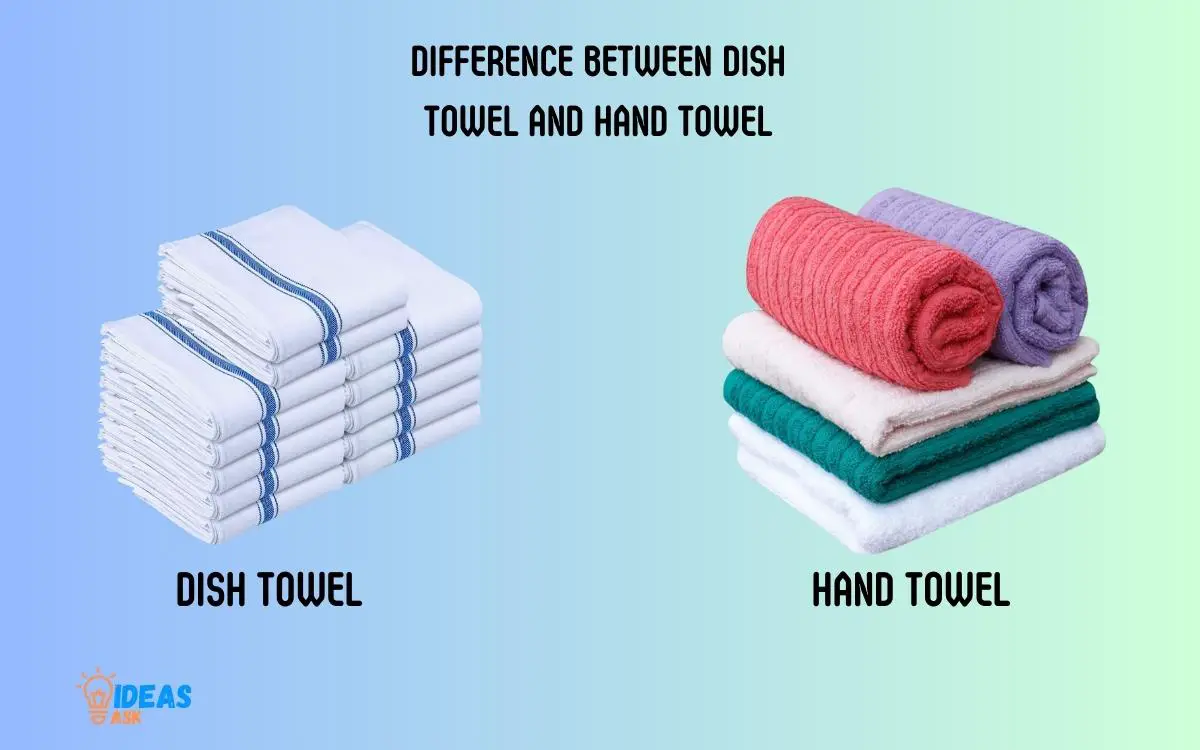Difference Between Dish Towel And Hand Towel: Explore!
A dish towel, also known as a tea towel, is specifically designed for kitchen use. It is used to dry dishes, cutlery, and other kitchen utensils, as well as to handle hot pots and pans.
A hand towel, on the other hand, is used for drying hands and is primarily found in the bathroom.
Dish towels and hand towels are both types of towels, but their purposes differ significantly. Dish towels are typically more durable and absorbent as they are used in a kitchen setting and often come into contact with food, water, and heat.
Hand towels, on the other hand, are usually softer and smaller as their main function is to dry hands and face.
While both dish towels and hand towels fulfill the primary function of drying, their utilization varies significantly.
Dish towels, due to their robustness, are meant to assist with kitchen tasks while hand towels are meant to cater to personal hygiene needs. Therefore, it’s essential to use the right type of towel according to its intended purpose.

Key Takeaway
Comparing Dish Towels and Hand Towels
| Features | Dish Towel | Hand Towel |
|---|---|---|
| Purpose | Mainly used to dry dishes and wipe down surfaces | Primarily used for drying hands |
| Material | Often made from cotton or microfiber for high absorbency | Usually made of cotton, linen or terry |
| Size | Usually larger, around 18 x 28 inches | Smaller, typically 16 x 30 inches |
| Design | Often have a loop for hanging and might feature patterns relevant to kitchen decor | More decorative, often adorned with fringes, embroidery, or fancy borders |
| Durability | More durable, must withstand frequent usage and washing | Not as durable, due to less rigorous usage |
| Absorbency | Needs to be highly absorbent to soak up water quickly | Requires less absorbency as it’s mostly used for drying hands |
Understanding The Purpose Of Dish Towels
Understanding the purpose of dish towels helps differentiate them from hand towels. Dish towels are designed specifically for drying dishes and kitchen cleaning tasks, while hand towels are primarily for personal hygiene purposes.
Their different functions make them distinct in usage and appearance. They are designed specifically for tasks like drying dishes, cleaning surfaces, and handling hot cookware.
Absorbent Properties For Drying Dishes:
- Dish towels are made from highly absorbent materials, such as cotton, linen, or microfiber. This allows them to efficiently soak up moisture from freshly washed dishes and utensils.
- The absorbent nature of dish towels helps to prevent moisture from lingering on the dishes, reducing the chances of bacterial growth and mold formation.
- Their absorbency also ensures that the dishes dry faster, reducing the risk of water spots or streaks, and ultimately leading to sparkling clean dishware.
Materials Commonly Used:
- Cotton: Dish towels made from cotton are extremely popular due to their excellent absorbency, durability, and softness. They are also easy to clean and maintain.
- Linen: Linen dish towels offer exceptional absorbency and are known for their lint-free properties. They are great for drying delicate glassware and achieving a streak-free finish.
- Microfiber: Microfiber dish towels are made from synthetic materials and are highly absorbent. They are effective in picking up small particles and leave surfaces lint-free.
Size And Dimensions:
- Generally, dish towels come in a rectangular shape, with dimensions ranging from 16×16 inches to 20×30 inches.
- The size may vary depending on personal preference and specific use. Smaller dish towels can be handy for quick tasks, while larger ones provide more surface area for drying larger cooking utensils and pots.
Typical Designs And Patterns:
- Dish towels come in a wide range of designs and patterns, adding a touch of style to your kitchen decor.
- Common designs include stripes, checkered patterns, floral prints, or plain solid colors.
- Additionally, dish towels may feature decorative borders or embroidery, showcasing creativity and individuality.
Understanding the purpose and distinctive features of dish towels allows you to make an informed choice when selecting the most suitable option for your kitchen.
Whether you prioritize absorbency, material, size, or design, finding the perfect dish towel that meets your needs is crucial for a functional and aesthetically pleasing kitchen space.
Exploring The Functions Of Hand Towels
Hand towels and dish towels serve different purposes in the kitchen. While hand towels are designed for personal hygiene, dish towels are used for drying dishes and cleaning surfaces.
Understanding the distinction between the two can help in maintaining cleanliness and organization in the kitchen.
Hand towels are an essential component of household items, often used in a variety of situations. From personal hygiene to general-purpose tasks, hand towels serve multiple functions, each catering to different needs.
Uses In Personal Hygiene:
Hand towels play a crucial role in maintaining personal hygiene and cleanliness. They are specifically designed for drying hands and face, ensuring optimal freshness and hygiene.
Here are some key uses of hand towels in personal care:
- Drying hands after washing them thoroughly helps remove excess moisture and prevent the spread of germs.
- Gentle on the skin, hand towels are ideal for drying the face and ensuring a clean, refreshed feeling.
- Hand towels can be used for wiping sweat during physical activities or after a workout session.
- In bathrooms, hand towels serve as functional accessories, adding a touch of style and convenience.
Varieties Of Hand Towels Available:
Hand towels come in an array of varieties, offering different features and benefits.
Depending on personal preferences and requirements, you can choose from the following options:
- Terry cloth hand towels: Known for their absorbency, softness, and durability, terry cloth towels are a popular choice in bathrooms and kitchens.
- Microfiber hand towels: These towels are highly absorbent and dry quickly, making them suitable for travel, sports, and everyday use.
- Decorative hand towels: Mostly used for decorative purposes, these towels often feature intricate patterns and designs, adding a touch of style to any space.
- Disposable hand towels: Ideal for events or public spaces, disposable hand towels offer convenience and hygiene, usually used once before disposal.
Ideal Materials For Hand Towels:
Hand towels are available in several materials, each with its unique properties.
Here are some commonly used materials and their benefits:
- Cotton: Cotton hand towels are soft, comfortable, and highly absorbent, making them a popular choice for daily use. They are also easy to care for and maintain.
- Bamboo: Hand towels made from bamboo fibers are eco-friendly, antimicrobial, and hypoallergenic. These towels provide exceptional softness and absorbency.
- Linen: Linen hand towels are lightweight and known for their quick-drying properties. They are perfect for use in hot weather or during outdoor activities.
- Microfiber: Microfiber hand towels are ultra-soft and highly absorbent. They are effective in drying hands quickly and are also resistant to stains and odors.
Size And Dimensions For Different Uses:
Hand towels come in various sizes, with dimensions tailored to specific uses. The appropriate size of a hand towel depends on its purpose.
Here are some common hand towel sizes and their intended uses:
- Small hand towels (12×12 inches): Often used as tea towels, for drying hands in the kitchen, or for decorative purposes in bathrooms.
- Medium hand towels (16×24 inches): Suitable for daily use in bathrooms, gyms, or for traveling.
- Large hand towels (20×30 inches): Ideal for multiple purposes, including drying hands and faces, as well as general cleaning tasks in kitchens and bathrooms.
Understanding the functions, varieties, materials, and dimensions of hand towels allows you to choose the right towels for your specific needs.
Whether it’s for personal hygiene or general-purpose use, hand towels undoubtedly play a significant role in maintaining cleanliness and convenience throughout your home.
Comparing Absorbency And Durability
Absorbency and durability are key factors when comparing dish towels and hand towels. While dish towels excel in absorbing moisture and are made to withstand heavy use in the kitchen, hand towels are designed for lighter tasks and often prioritize softness and comfort.
Absorbency and durability are two crucial factors to consider when choosing between a dish towel and a hand towel.
Both towels serve different purposes, and their characteristics play a significant role in their functionality.
Factors Affecting Absorbency:
- Fiber composition: The type of fibers used in a towel heavily influences its absorbency. Towels made from natural fibers like cotton or linen tend to have better absorbent qualities compared to synthetic fibers.
- Construction: The way a towel is woven affects its ability to absorb moisture effectively. Towels with a tight weave pattern, like terry cloth, are known for their high absorbency.
- Pile height: Towels with a higher pile height generally have improved absorbency. The longer threads in the pile allow them to hold and retain more moisture.
Resistance To Wear And Tear:
- Towel thickness: A thicker towel tends to be more durable and resistant to wear and tear. It can withstand repeated use and washing without losing its quality or performance.
- Stitching quality: Towels with well-stitched edges and reinforced seams are less likely to fray or unravel over time. Strong stitching enhances a towel’s longevity and keeps it intact even after extensive use.
- Fabric strength: Towels made from stronger fabrics, such as high-quality cotton, are more resistant to wear and tear. These towels can handle frequent washing and maintain their structural integrity for a longer period.
Usage Longevity Of Dish Towels:
- Purpose-specific material: Dish towels are designed to withstand the rigors of kitchen tasks. They are often made from highly absorbent fibers like cotton, linen, or microfiber, which are durable and resist staining. This specialized material ensures that dish towels can be used repeatedly without losing their functionality or becoming unsightly.
- Proper care and maintenance: Regular washing, avoiding harsh chemicals, and following manufacturer’s instructions contribute to the longevity of dish towels. By taking care of these towels, you can extend their useful life and maintain their absorbent properties.
Pros And Cons Of Hand Towel Absorbency:
Pros:
- Hand towels are smaller in size, making them convenient for quick drying tasks.
- Their compactness allows for easy storage in small spaces.
- Hand towels are versatile and can be used for various purposes, such as drying hands, face, or small spills.
- They dry quickly, thanks to their reduced surface area, making them ready for use again sooner.
Cons:
- Hand towels have limited absorbency compared to larger towels, which may require more frequent replacement during heavy-duty tasks.
- Spills or larger volumes of liquid may not be efficiently absorbed by hand towels, necessitating extra effort or multiple towels.
Choosing the right towel depends on your specific needs and preferences. Consider the factors discussed above to ensure that your towel selection aligns with the absorbency and durability required for its intended use.
Analyzing Hygienic Considerations
Discover the contrasting features between dish towels and hand towels by analyzing their hygienic considerations. Understand their differences to make informed decisions about their usage in your everyday routines.
Bacterial Contamination Risks With Dish Towels:
- Cross-contamination: Dish towels can easily transfer bacteria from different surfaces, such as countertops, cutting boards, and utensils. This increases the risk of foodborne illnesses.
- Moisture retention: The dampness of dish towels provides an ideal breeding ground for bacteria, including pathogens like E. Coli and salmonella.
- Accumulation of stains and food particles: If left uncleaned, dish towels can harbor stains and food debris, promoting bacterial growth.
Proper Cleaning And Maintenance Of Dish Towels:
- Regular washing: Dedicate specific dish towels for certain tasks and wash them frequently, at least every two to three days.
- Hot water and detergent: Use hot water, preferably above 140°F (60°C), along with a strong detergent to effectively eliminate bacteria and remove stains.
- Separate from other laundry: Wash dish towels separately from other clothes to avoid cross-contamination.
- Drying: Ensure dish towels are completely dry before reuse as moisture prolongs bacterial survival.
Hand Towel Hygiene Practices:
- Individual towels: Assign personal hand towels to each family member, limiting the spread of bacteria.
- Regular replacement: Replace hand towels every two to three days to prevent bacterial buildup.
- Proper hand-washing: Encourage everyone to wash their hands thoroughly before using a hand towel to minimize the transfer of bacteria.
Strategies To Keep Both Types Clean And Safe:
- Color-coded system: Assign different colors for dish towels used in various areas, such as the bathroom, kitchen, and dining areas. This helps avoid mixing them up and reduces cross-contamination risks.
- Segregate different tasks: Use separate dish towels for drying dishes, wiping countertops, and cleaning spills to prevent the spread of bacteria across different surfaces.
- Air drying: Whenever possible, allow both dish towels and hand towels to air dry in a well-ventilated area to minimize bacterial growth.
By understanding the specific hygienic considerations associated with dish towels and hand towels, you can implement proper cleaning practices to maintain a clean and safe environment in your home.
Remember, regular washing, individual usage, and practicing good hand hygiene are key to minimizing bacterial contamination risks and promoting overall cleanliness.
Assessing Versatility And Aesthetic Appeal
Discover the dissimilarity between dish towels and hand towels in terms of their versatility and aesthetic appeal.
Explore their unique features and understand how each towel serves different purposes in your kitchen and bathroom.
When it comes to choosing the right towels for your kitchen and bathroom, it’s essential to consider both their versatility and aesthetic appeal. Dish towels and hand towels are two common types that serve different purposes.
Alternative Uses For Dish Towels:
Dish towels are primarily designed for drying dishes and handling hot pots and pans. However, their functionality extends beyond the kitchen.
Here are some alternative uses for dish towels:
- Cleaning and wiping surfaces: Dish towels are great for wiping down countertops, tables, and stovetops.
- Serving as a makeshift potholder: In a pinch, dish towels can be folded and used to handle hot dishes.
- Acting as a barrier: Place dish towels under cutting boards or mixing bowls to prevent them from slipping.
Styling Options For Hand Towels:
Hand towels, on the other hand, are softer and more absorbent, making them ideal for drying hands in the bathroom. They also offer opportunities for adding style and personality to your space.
Consider the following styling options for hand towels:
- Color coordination: Choose hand towels that complement the color scheme of your bathroom or kitchen. This can create a cohesive and visually pleasing look.
- Patterns and textures: Opt for hand towels with interesting patterns or textures to add visual interest and depth to the space.
- Embellishments and trims: Hand towels with decorative edges or embellishments can bring a touch of elegance or playfulness to your decor.
Incorporating Both Types In Home Decor:
In many households, both dish towels and hand towels are regularly used. To achieve a harmonious aesthetic, it’s important to consider their coordination.
Here are some tips for incorporating both types in your home decor:
- Maintain consistency: Choose dish towels and hand towels that share a similar style or color palette to create a cohesive look throughout your kitchen and bathroom areas.
- Mix and match: Experiment with different patterns, textures, and colors to add visual interest while still maintaining a cohesive theme.
- Consider the overall ambiance: Think about the atmosphere you want to create in each space. For a more casual and homey vibe, opt for cozy and rustic-looking towels. If you prefer a more elegant and sophisticated atmosphere, choose towels with subtle patterns or a luxurious texture.
Impact On Overall Aesthetic Of Kitchen And Bathroom Areas:
The choice between dish towels and hand towels can significantly impact the overall aesthetic of your kitchen and bathroom areas.
Here are some ways their selection can influence the ambiance:
- Kitchen ambiance: Dish towels with vibrant colors or playful patterns can add a lively and energetic feel to your kitchen. Conversely, neutral or earth-toned towels can contribute to a more calming and rustic ambiance.
- Bathroom ambiance: Hand towels that match the color scheme and decor of your bathroom can create a polished and well-coordinated look. Consider towels with soft and plush textures to evoke a sense of luxury and relaxation.
When assessing the versatility and aesthetic appeal of dish towels and hand towels, it’s important to consider their alternative uses, styling options, and the impact they have on the overall ambiance of your kitchen and bathroom areas.
By carefully selecting and coordinating these towels, you can enhance the visual appeal of these spaces while also ensuring they fulfill their practical functions.
Conclusion
Understanding the differences between dish towels and hand towels can greatly enhance your kitchen and bathroom experiences.
Dish towels are specifically designed for tasks such as drying dishes and wiping down countertops, while hand towels are primarily used for drying hands in the bathroom or after meal preparation.
Dish towels are usually larger and more absorbent, with a rough texture to help with scrubbing. On the other hand, hand towels are smaller, softer, and more aesthetically pleasing.
Choosing the right towel for the right task is essential for maintaining hygiene and maximizing efficiency.
By using dish towels for their intended purpose and hand towels for hand drying, you can keep your kitchen and bathroom clean and organized. Invest in quality, durable towels that are easy to clean and maintain.
With this knowledge, you can now confidently select the appropriate towel for each task, ensuring a happy and efficient home.






